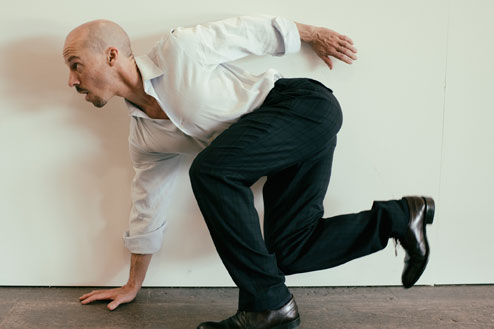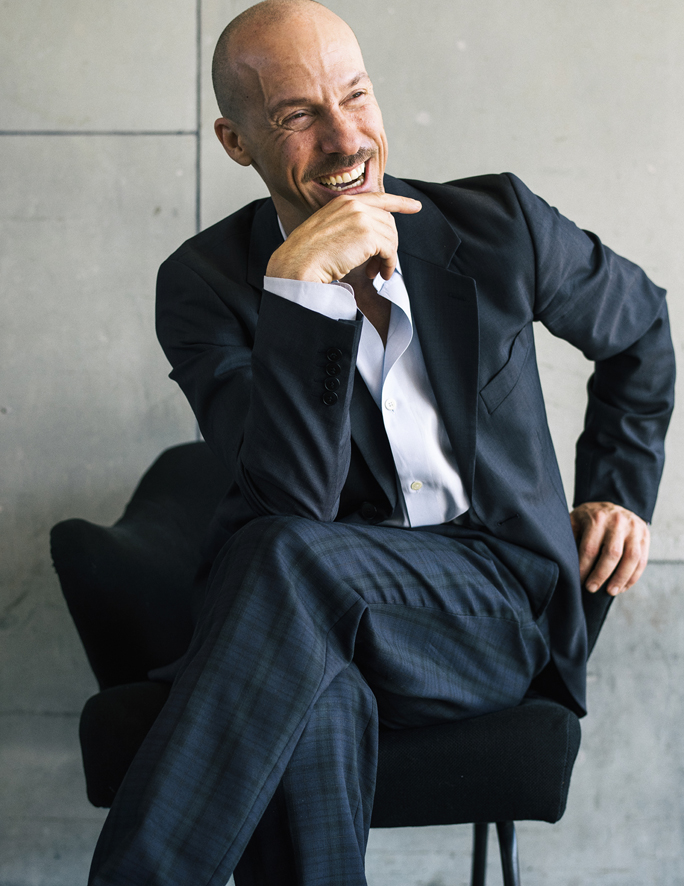Interview with Richard Siegal: The Total Dance Theatre and Txtorrent
by Carmen Kovacs

All works shown during the festival will be read with reference to and in relation to specific Bauhaus phenomena and achievements. How is the relationship between reference and originality arranged in the two works that you have created for the festival?
In all honesty I don’t think about whether or not what I do is original. But I do think about where the ideas come from. And I think that one’s own originality doesn’t simply appear without any kind of reference at all. Really, I mean you can measure originality on its effects. If we take Stravinsky’s Sacre du printemps, for example – such a thing would never simply fall from the heavens, but rather is embedded in a complex field of cultural concatenations, which have grown historically. Can we claim that at precisely that moment something “new” was produced? Or was it far more the birth of an idea, which had grown over a longer period? And which then integrates itself just like that into the cultural fabric, and becomes part of it. I think things work very similarly with the Bauhaus. It is in us, deeply rooted by now, and all we can do is own it. But just being born into this cultural heritage just isn’t enough. You’ve got to involve yourself, actively get in there and deal with it.
You do just that with two very different pieces of work. How did you approach your artistic “examination” of the Bauhaus?
Well, let me say straight away: I do not consider myself an expert or authority in the Bauhaus area, which would probably be a good attribute for such an artistic examination. But of course the consequences that the Bauhaus has left in its wake are also present in my life – and that since I’ve been able to think. I have a strong affinity with the Bauhaus’s working methods, because the work with my company, Ballet of Difference, is based on similar values and principles. But I also do really think that every contemporary art stands on the shoulders of the Bauhaus, because ideas have merged with one another here and are visible and perceptible within the shaping of an institutional phenomenon, which still provides a foundation for many artists today. These were exciting times as well, especially with regard to the early stage of mass communication. In this context I first focused on Ise Gropius, Walter Gropius’s wife, who had a big influence on the Bauhaus’s “branding” and communicated the image to the outside world. Today we’d call this “PR” and “marketing”. During the research phase I then came across Oskar Schlemmer’s non-literary handling of language – and I was fascinated, because I had already been working on this approach to language for quite a while. Without knowing it I had “inherited” Schlemmer’s ideas and was (just as he was) interested in getting closer to text and language in a non-literary way or, “... simply elementary, as it happens, as if only just heard for the first time ...” (Oskar Schlemmer, 1927). I’ve also found this approach to language in Kurt Schwitters’s work, who of course was also connected with the Bauhaus artists. This inspired me to design a piece that tackles text and spoken language. I was lucky enough to bring on board two superb artists for this, namely the actor Sandra Hüller and the musician and composer Carsten Nicolai, who many will know as Alva Noto.
Why did you want to work with these two artists in particular?
Because the performing arts function via collaborative processes, if you want to work with the best. It is truly exceptional what these two do, and it inspires me so much. It was also exciting for me that Sandra and Carsten had never met at this point. I like bringing people together to form ideas and sensibilities together. I’ve already choreographed in the past to Carsten’s music, but I’d never had the opportunity of working with him in person. I’ve gotten to know Sandra more in private life over recent years, and at the same time I have the greatest respect for her work as an actor.
What is the result when a choreographer does not work together with dancers?
Thinking and acting beyond genre borders is really Bauhaus. For me personally it means that my work and my thinking in particular are not limited by genre labels. I want to be free to work in every medium that touches me. That Sandra is not strictly speaking a dancer and I am not a director does not prevent me from working with her. On the contrary, I am always on the lookout for uncomfortable situations, from which I can learn.
What role does the music in TXTORRENT play?
We will try to develop strategies, the three of us together, in which the music and Sandra’s performance interact with one another. With the computer as a digital instrument, Carsten has a powerful and virtuoso “tool” in his hands, with which he can react in real time to the use of language, voice, movement or even sounds that Sandra produces through her body – and therefore will also be seen on the stage. And this in turn has an effect on Sandra, so that the two can have a kind of conversation with one another through various means, in different languages. It will be interesting to see if the spoken language doesn’t just work at semantic level, but rather also becomes the signal that starts another musical process, which, for example, follows its very own musical logic – and suddenly becomes poetry. It’s like a game, entirely without hierarchy within the elements, rather more like a feedback loop. Of course both must be highly alert to react to one another and be able to make decisions. Sandra will also have headphones, which play back her recorded text material. She can then decide on which material, and also when and how she gives it a voice, how she interprets it. And this voice will in turn become a musical instrument for Carsten.

How will language and movement be made to interact with one another?
I have been working on how language or text and movement behave with one another for quite some time now. This is one of the initial questions that I also ask myself and which will only be answered by the collaborative work in the rehearsal process. I can imagine how movement can be a kind of counterpoint to the “text torrent”, so to the flood of text that comes out of Sandra. I think ideally it is all about an almost meditative and highly concentrated state here, in which one listens and produces at the same time. But you’ve got to be able to let yourself go for this, take a step back from your own reflective thoughts and no longer think actively and awkwardly about what you are producing at that precise moment. And then comes the flow.
Is it pure dance at the end? What’s your prognosis?
What does “pure” mean, or “dance”, and when is “the end”? I think the question we’ve got to ask ourselves here is about the conflict between innovation and preservation – two forces that are constantly interacting with one another. There are conventions and rules in dance as well, and in a certain way there are also specific excluding codes of conduct, which are worthwhile preserving, because they have created forms with which we still work and which are part of our identity. But of course every artistic practice inevitably also comes into contact with the development of modern technologies, which logically creates new forms. And at the end everything that is preserved was once an innovation, which has developed and established itself within our culture.
And the development of modern technologies is key for your second artistic contribution to the Bauhaus festival – a choreography that is part of a virtual reality installation. In the continuation of Gropius’s visions “Das Totale Tanz Theater” (Total Dance Theatre) is an immersive and interactive experience. So what happens?
Within the installation, through which we can move with VR glasses, the visitor not only becomes a user, they actually become a dancer to some degree. You have the feeling that you are participating. It is all about being activated as a participant. There are four stages to go through here, each with a different degree of autonomy or ability to act. You can move through the choreography – and the dancers react to the users, according to the stage. The ability to move is, however, reduced more and more within the installation.
Total theatre was a theatre of the future for Gropius. Now VR is currently all the rage and the VR glasses required for it are also an incredibly exciting tool, which, however, also has a restricting effect and will transform significantly in the years ahead of us. So will the installation help to provide us something of a preview into the future?
I think you’re right. The VR project is an intermediate step towards a theatrical form of expression, which is yet to come. A form that is much more interactive and which gives users more power to act. The project shows us technological potential that will allow us to have more and more sensory experiences, and not just visually, but haptically as well. Artificial intelligence will enable even much more complex interaction with machine entities. This will change everything. Everything that is possible within the VR project is simply fantastic! However it is limited by the hardware – but we’re on the way, for sure.
Good point. What is real?
The visual impression that you are hundreds of meters above the earth does something to you, even though you know that it’s not “real”. The body nevertheless reacts to it and this makes it almost hyper-real. The fear, the dizziness, breaking out in sweat – that’s all real. Sometimes I think virtual reality simply supports us in one of our most beautiful abilities, which children are still really good at – our ability to fantasise.